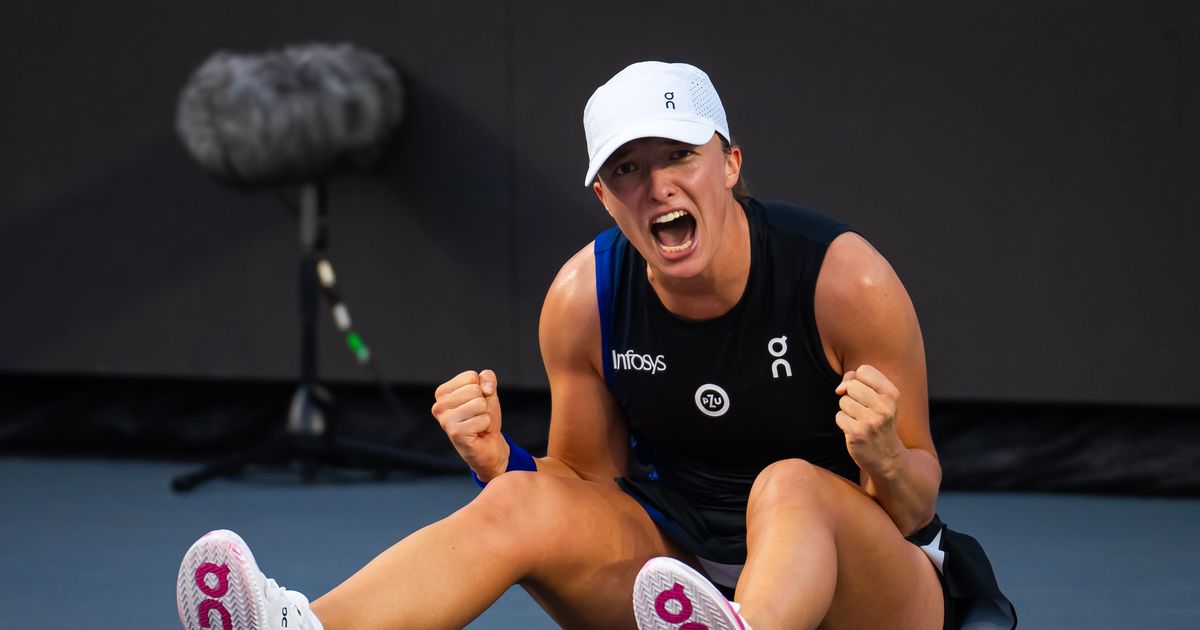
Iga Swiatek was in bed at her Miami apartment when she received the staggering news: Ashleigh Barty, the world’s best player for the past three years, was retiring at the age of 25.
“They said it may be possible that I’m going to be World No.1,” Swiatek told reporters a little over two years ago. “It would be for me something special. I never expected that if it’s going to happen, it’s going to happen that way.”
Abdicating the throne, Barty asked to be removed immediately from the rankings with a lead over Swiatek of more than 2,200 ranking points. And so, the 20-year-old from Poland was one match-win away from becoming the No.1 player.
“I was crying for a long time,” Swiatek said. “I mean, there was lot of confusion in me, for sure.”
Since then, Swiatek has been anything but confused. On Monday, she’ll reach 100 weeks as the Hologic WTA Tour’s top player.
A ‘pretty good group’
A century –100 years — is a long, long time. The Internet is less than 50 years old and look how it’s transformed our lives. In the compressed world of professional tennis, where careers can be measured in a single decade, 100 weeks is a long time, too.
“No kidding,” said 18-time Grand Slam singles champion Martina Navratilova. “How many people have done that?”
This is the 50th year the WTA Tour has compiled rankings and only nine women have held the No.1 ranking for 100 weeks or more.
Savor these Hall of Fame names: Steffi Graf, (377), Martina Navratilova (332), Serena Williams (319), Chris Evert (260), Martina Hingis (209), Monica Seles (178), Ashleigh Barty (121) and Justine Henin (117).
And now Swiatek is one of them.
“It means you are not a flash in the pan, but consistent, focused, and hungry to maintain a high standard for a long period of time,” Evert said. “It means you don’t look back and settle for some high moments but are determined and committed to be in the present and work even harder.”
Swiatek, at 22 years and 326 days, is the fifth youngest player to reach 100 weeks as World No.1. She has already won four Grand Slam singles titles and will be favored to win a fifth at Roland Garros in June.
Four months of flawless tennis
Swiatek was ranked No.9 at the start of the 2022 season. And while she had broken through with her first major singles title in the fall of 2020 at Roland Garros, otherwise there was scant evidence of the spectacular success that was to unfold.
Her first loss of the year, perhaps appropriately, came against Barty in the semifinals of Adelaide. Later, Swiatek would say that playing Barty, with all her slice-and-dice diversity — and developing the defense to combat it — made her a more complete player. She lost in the semifinals in Melbourne (to Danielle Collins) and in her second Dubai match to Jelena Ostapenko.
Swiatek wouldn’t lose again for 136 days.
The run started in Doha, where she won the title, defeating three Top 10 players at the end — Aryna Sabalenka, Maria Sakkari and Anett Kontaveit. Swiatek was the winner in Indian Wells (over Sakkari in the final) and rose to the No.2 ranking. This, she said, was the first time she first contemplated the possibility of the No.1 ranking. The rare Sunshine Double was accomplished in Miami with wins over Coco Gauff, Petra Kvitova, Jessica Pegula and Naomi Osaka.
After winning both of her Billie Jean King cup matches against Romania, Swiatek kept it going in Stuttgart by taking her fourth straight title. She beat Sabalenka in a straight-sets final. The result was the same in Rome, where Swiatek took her third WTA Tour 1000 of the year and ran her streak to 28 straight matches.
Make that 35. Swiatek’s last four victories at Roland Garros were all over future Top 10 players — Gauff, Daria Kasatkina, Pegula and Zheng Qinwen. It was her second title on the red clay in Paris in three years.
The transition to grass proved to be the deal-breaker. Swiatek managed to beat two qualifiers at Wimbledon before falling to Alize Cornet in straight sets.
In each and every tournament, all players but one are destined to lose. For more than four months and six events, Swiatek never experienced that empty feeling. Far from being daunted by the enormous weight of expectation that comes with No.1, she actually seemed energized by it.
Those 37 consecutive match-wins were the longest WTA Tour streak since Hingis posted 37 straight some 25 years earlier.
An unlikely reclamation project
Swiatek finished the season strong, winning the US Open and collecting her first year-end No.1. It was much the same in 2023. In retrospect, the sequel only suffered in comparison to the year before.
“Everybody’s after you,” Navratilova said. “Every single person. You are going to be on their resume forever, because how many times do you beat a No.1 player in the world?
“You can’t win, you cannot move up in the rankings. You can only widen the gap.”
Swiatek repeated her titles in Doha, Stuttgart and at Roland Garros, but with so many points to defend, Sabalenka gradually ran her down. When Swiatek went out in the fourth round in New York and Sabalenka advanced to the final, the run at No.1 was over at 75 weeks.
At that point, it seemed likely Sabalenka would finish as the year-end No.1. Swiatek, though, wasn’t accepting that popular narrative.
After splitting matches in Tokyo, losing to Veronika Kudermetova, Swiatek went on another one of her streaks. At the WTA 1000 in Beijing, she beat Top 10 players Gauff and Caroline Garcia on the way to the title.
Heading into the WTA Finals in Cancun, Swiatek knew precisely what she had to do — and she went on to do it with precision. Swiatek dusted Marketa Vondrousova, Ons Jabeur and Coco Gauff in the group stage — in straight sets. And then lifted her game even higher.
Her semifinal match against Sabalenka was essentially a winner-take-all confrontation. Over two rainy, difficult days, Swiatek carved out a 6-3, 6-2 win to give herself a chance to regain the No.1. The final was an anticlimactic 6-1, 6-0 victory over Pegula.
Sabalenka, who held the championship belt for eight weeks, thus was relieved of that burden. Swiatek finished the season with 11 straight victories. And took home her tour-leading sixth title. She lost only 20 games in Cancun, easily a WTA Finals record.
“Coming back to World No.1, it’s a dream come true, for sure,” Swiatek said afterward. “I would say I wasn’t expecting that right now, this season. I was hoping that maybe next year is going to be my year, but it seems like just working hard and focusing on the right things at the end worked.”
This year, she remains focused — and it’s still working.
At 24-4 this year, Iga Swiatek holds a record of 123-20 as the top-ranked player.
She’s the only player to win more than one WTA 1000 (Doha and Indian Wells) and the welcoming European clay season beckons; Swiatek has lost a total of three matches on clay in the past two years.
Among the 10 players who have held the No.1 ranking in the past decade, Swiatek (86.2 percent, 119-19) trails only Serena Williams (88.3 percent, 143-19) for winning percentage as No.1 over that span.
While Navratilova acknowledges that total weeks at No.1 is a valid statistic, she prizes a more bottom-line analysis.
“There’s been a bunch of No.1s [29]but they weren’t all No.1 at the end of the year,” she said. “For me, it’s how many times you’ve been No.1 at the end of the year.”
Swiatek, who turns 23 on the last day of May, is in position to achieve a rare three-peat. She has a 2,700-point lead on No.2 Sabalenka and is looking to become only the sixth woman to hold the No.1 year-end ranking for three consecutive seasons, following Evert (1975-77), Navratilova (1982-86), Graf (1987-90, 93-96), Williams (2013-15) and Barty (2019-21).
“One-hundred weeks at No.1 is a huge achievement in any era. Congratulations to Iga. I’m so happy for her and have loved watching her hard work pay off,” Barty said.
Source: https://www.wtatennis.com/news/3976689/the-swiatek-era-reflecting-on-100-weeks-atop-the-wta-rankings


